Developing Confident Horses
|
|
This page is a continuation from Part Six.
Success: the accomplishment of an aim or purpose. Our efforts are intended to produce horses that have social connections with their handlers and riders, maintain confidence in a wide variety of situations and under many different conditions, and are safe to handle and ride. Therefore we focus heavily on relationships, communication and confidence building early on in the process. After a horse is completely comfortable around people, being handled, being placed in challenging situations and being ridden (comfortable with a rider aboard, including in challenging situations) we will then move on to the finer points of equitation. That's not to say that we don't engage in activities designed to produce a soft feel on the line or reins, flexion, suppleness and a consistent response to various cues, but our primary objective is for the horse to feel confident before we worry about him becoming competent. An anxious horse is a potentially dangerous horse. A confident horse will usually consider his or her handler's or rider's cues and respond more consistently if things become confusing or stressful. As stated previously, there are a number of sensible techniques that can be applied for the training and development of reliable horses and it is not the purpose of this feature to delve into them. Our message in this presentation is that simple, basic engagement of the horse through effective communication and mutual respect - including an understanding of how a horse's emotions work and how they affect learning and safety - can consistently produce safe and trustworthy mounts. Once the horse is safe and reliable, we can then proceed to the finer elements of saddle work.
Performing a "pre-flight check" before sitting in the saddle. (Horse's second time being saddled.)
|
Return to Part Six
Return to The Beginning
Press "Back" to return to the page which brought you here
Go to KBR Training Section
Go to LRTC Wild Horse Mentors
Go to KBR World of Wild Horses & Burros
Go to other Wild Horse Links
Go To  KBR Horse Net
KBR Horse Net
|
KBR Horse Training Information, © 2015 Lamm's Kickin' Back
Ranch and Willis & Sharon Lamm. All rights reserved. Duplication of any of this material for
commercial use is prohibited without express written permission. This prohibition is
not intended to extend to personal non-commercial use, including sharing with others for
safety and learning purposes, provided this copyright notice is attached. Email us to submit comments or request reproduction permission. |








